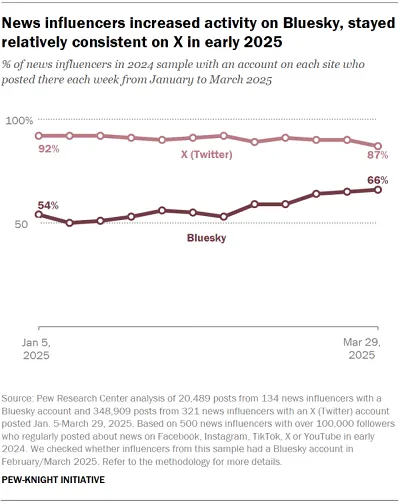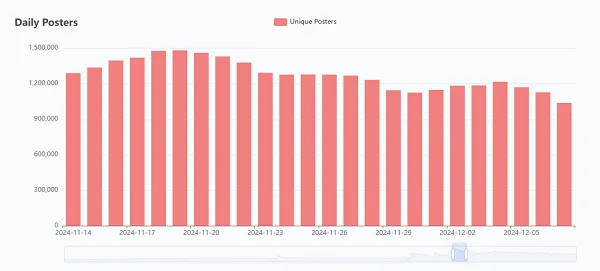While Bluesky’s growth has slowed of late, there is one user cohort in which it continues to gain traction, with news influencers increasingly turning to Bluesky as an alternative to X.
Or, really, as a supplement to the app formerly known as Twitter.
According to a new study conducted by Pew Research Center, many news influencers, especially left-leaning ones, are indeed now also active on Bluesky, yet they continue to post on X as well, reflecting something of a soft protest to Elon Musk’s changes at the app.
As you can see in this chart, based on a selection of 500 news influencers identified by Pew, each with more than 100k followers on X, many of them have now activated a Bluesky profile, in addition to their original X presence.
Bluesky activity ramped up after the 2024 U.S. election, with the pervading sentiment being that many people had grown increasingly concerned about Elon Musk’s rising political influence, and were therefore seeking to move away from X.
But they haven’t exactly abandoned Elon’s social project:

As you can see in this chart, while more news influencers are now also active on Bluesky, their posting activity on X hasn’t declined in a significant way.
As per Pew:
“About half (54%) of news influencers on Bluesky posted there in the first full week of January, but this share grew to 66% in the last full week of March. During the same period, X remained popular but saw a small decline in activity: 92% of news influencers on X posted there in the first full week of January, compared with 87% in the last full week of March.”
So while Bluesky has gained momentum, it’s not close to surpassing X as the leading news platform as yet, with most left-leaning influencers who are posting on Bluesky still maintaining their activity on Elon’s app.
The data is reflective of both the opportunity and challenge ahead of Bluesky, with the app’s decentralized social approach appealing to those in the know, who have strong views about a free and open web. Yet, for most regular users, decentralized social doesn’t mean much, and they don’t really care what’s being shared where, nor how they can control their personal data.
Most people will simply go wherever the crowd is, which is why X remains popular, as it has a far bigger audience (reportedly 600 million users per month) than Bluesky (36 million).
Bluesky has also been surpassed by Meta’s Threads, which is now up to 350 million actives. That’s despite Threads being owned by another tech billionaire, as opposed to going the open-source, freedom-focused, decentralized route.
Sure, Threads has its own Fediverse sharing elements as well, but it remains an experimental element, and I’d assume that Meta simply hasn’t seen the demand or interest in such to make it more of a focus.
Threads is actually a perfect example of how the open network approach isn’t catching on, despite a lot of media hype. Because while a lot of media commentators are supporters of a more open approach, which is why these influencers are now active on Bluesky, it’s Threads that’s seeing major growth momentum, versus Bluesky, which has continued to slow after its post-election boost.
So does that mean that it’s all over for Bluesky?
Well, no.
Every time one of the big players slips up, and does something that annoys user sensibilities, there’ll be another surge towards Bluesky again. If, for example, Elon was to sell X user data to a third-party AI project, or Meta announced a significant reduction in the reach of link posts in Threads. Things like this will spark negative media coverage, and commentators will once again point to open protocols as a means to side-step corporate, rich-guy-influenced control.
Yet, despite that all being true, all being valuable, all relevant info for maintaining important oversight in the modern digital age, where all of our information is online, it’s still all about critical mass. And also, convenience.
People will only use a social app if there’s content there that they want to see, users, creators and brands that they want to engage with. And if Bluesky can’t get that critical momentum, with a significant amount of relevant creators, it just won’t pull in a crowd.
And on the convenience front, as we saw with Mastodon, while being able to dictate which specific server you connect to, which rules are in place for each, and the algorithm weights that dictate your experience, most people will opt for a simpler, set-up and log-in approach, regardless of the expanded benefits.
And looking at Bluesky’s daily post activity, in regards to the number of people posting to the app, the signs are not great:

After the U.S. election, Bluesky reached a peak of 1.5 million daily posters. That’s now declined by a third, and it’s steadily falling, as Threads continues to rise.
Which supports Pew’s findings, that important high-profile, left-leaning creators are hedging their bets by posting to Bluesky, yet they’re also not going all in on the app.
Which means users can still see their content on the platforms where they already have an established profile and following, where they already know what to expect, and they don’t need to have an in-depth understanding of server-side architecture to understand how to connect.
So while many commentators may well be advocates for more control, more options, and more means to manage your social media experience, even they won’t abandon their audience reach on the main apps.



